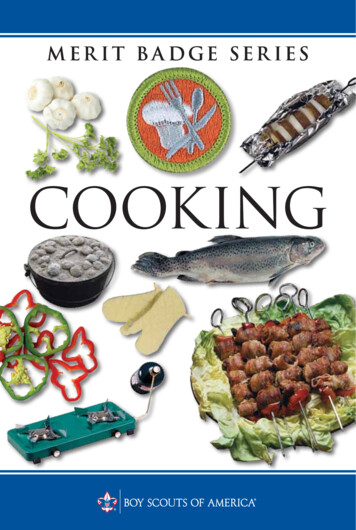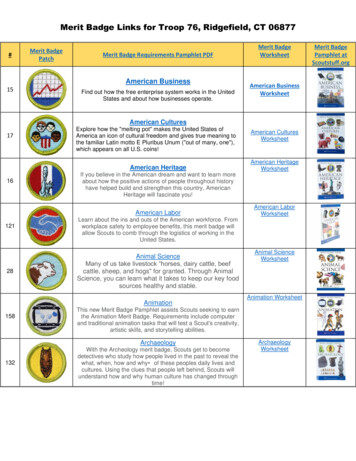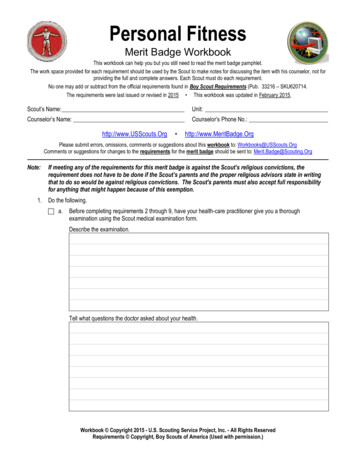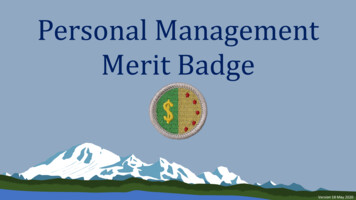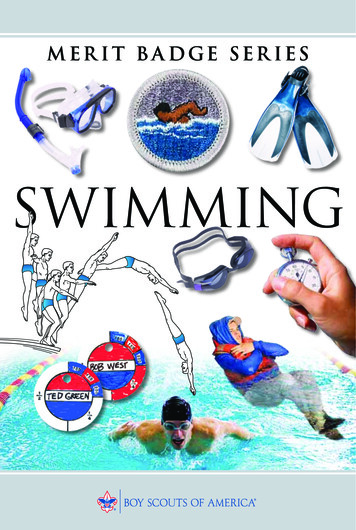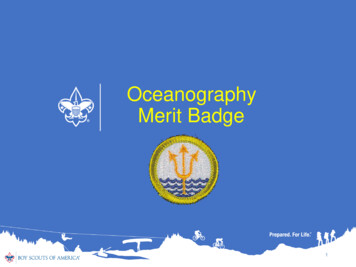
Transcription
OceanographyMerit Badge1
Mr. Frank Zarrilliupperdarbylawctr@aol.com(484) 326-8212 (cell)2
Requirements to earn OceanographyMerit Badge Participate in class discussion and fill out theOceanography Merit Badge Workbook (turn incompleted workbook at end of class on May 9th). For requirement 8a or 8b: Write a typed 500 wordessay (page and a half in Times New Roman font) onOceanography topic of your choice and submit to meelectronically by Sunday, March 29th. For requirement # 7: One of (a),(c) through (f). In thealternative, develop a series of 4 models of a volcanicisland. See, (Req. 7b).3
(Req.1) Name Four Branches ofOceanographyGeological Oceanography focuses on the topographic features and physical makeup of theocean floor4
Name Four Branches of OceanographyPhysical Oceanography deals with the motions of seawater, such as waves, tides, and currents5
Name Four Branches of OceanographyChemical Oceanography concerns the distribution of chemical compounds and chemical reaction in theocean and on the sea floor.6
Name Four Branches of OceanographyMeteorological OceanographyStudy of the ocean’s interaction with the atmosphere and its effect onweather and climate.7
Name Four Branches of OceanographyBiologicalConcentrates on plant and animal life In the oceans.8
(Req. 1 cont’d) Five reasons why it isimportant to learn about theOceans Essential part of the earth’s ecological system –covers 71% of the earth’s surface Influences and controls planet’s climate Maintains Earth’s Oxygen balance Huge source of food Source of valuable minerals Important for trade and commerce Possible future source of energy9
(Req. 2.) Salinity The amount of dissolved salts in seawater.Average salinity for the oceans 35 ppt (parts perthousand) Determined by measuring the conductivity of thewater through a submerged electrode10
(Req. 2) Temperature– Temperature is how hot or how cold water is. Measured using mercurythermometers. For samplingat depth thermometers areattached to Nansen bottles11
(Req. 2) Density A measure of the amount of material held in acertain space (mass per volume) Cold, deep, more saline water is denser. Densewater sinks, while less dense water rises – thiscontributes to ocean currents. Oceanographers calculate density fromtemperature, salinity, and pressure12
13
15
Describe the effects ofthe Oceans on Weather and Climate(Req. 2 cont’d)The ocean and the atmosphere work together to createweather patterns and climate. Water stores heat better than air and land, so the oceansabsorb over 50% of the sun’s radiation. As winds blows over the ocean, water evaporates andforms clouds and rain Winds flowing across the water create currents, which inturn regulate temperatures (London is more mild than newYork because of the Gulf Stream)17
Effects of the Oceans on Weather andClimate (Req. 2 cont’d)Climate Patterns are related to Currents18
(Req. 3) Describe Characteristics ofOcean Waves19
(Req. 3) Storm SurgeWhen strong winds of a hurricane push water towardsthe shore, causing the water level to raise 15 feet ormore.20
(Req. 3) Tsunami / Tidal WaveA huge wave created by an earthquake,volcanic eruption, or landslide.21
(Req. 3)Tidal BoreA tidal phenomenon where the leading edge ofthe incoming tide forms a wave that races up aninlet or river against the direction of the river orbay’s current.22
(Req. 3 cont’d)SeaWaves in the area of the oceandirectly affected by the wind –no regular pattern – “choppy”23
(Req. 3 cont’d)SwellWaves that fall in a regular pattern –crests are rounded.24
(Req. 3 cont’d)SurfOccurs near the shoreline whenwaves begin to “break.”25
(Req. 3)How Breakers are FormedAs shore depth gets shallower, waveheight gets higher, until the wavetopples over.26
(Req. 3 cont’d) How Breakers are Formed27
(Req. 4.) Cross-Section ofUnderwater Topography(Draw in Workbook)28
(Req. 4)(a.) Continental Shelf(b.) Continental Slope(c.) Abyssal Plain29
(Req. 5) List the main salts, gases, andnutrients in waterSalts: NaCl – Sodium Chloride30
Salts31
(Req. 5 cont’d)Some ImportantProperties of Water Universal solvent: dilutes nutrients for all life It serves as a cleaning agent, a heat absorber, asound transmitter, a shaper of shorelines, amedium for ships to sail upon and hurricanes toform. Only water can exist as a solid, a liquid, or a gas– ice, water, or water vapor. Water molecules, in any form, are always moving;those at the oceans surface enter the air as vapor–a process called evaporation. Each water molecule has two atoms of hydrogenand one of oxygen H²O
(Req. 5 Cont’d)How do Animals and Plants affectthe Chemical Composition ofSeawater?33
How do Animals and Plants effectChemical Composition of Seawater34
35
(Req. 5 cont’d)Explain how differences inevaporation and precipitation affectthe salt content of oceans?*Areas around the equator have warmtemperatures and high evaporation and few riversflowing into ocean; so they tend to be saltier thanother oceans.*Other areas, like the Gulf of Alaska, have a lowrate of evaporation, a lot of precipitation, andmany fresh water rivers flowing into the ocean; sothey tend to have lower average salinity.36
37
(Req. 6) Some Biologically ImportantProperties of Seawater Assists in digestion of food by actingas a solvent Necessary for photosynthesis Necessary for respiration38
39
40
Nekton41
Plankton42
Plankton43
Plankton44
Phyto-Plankton45
Req. 7(b) Make a series of modelsshowing the growth of a volcanic islandWill be completed in class May 9th46
47
48
49
(Req. 9)Describe four methods thatmarine scientists use toinvestigate the ocean1. Research Ships2. Submarines3. Remote sensing devices(radar and sonar)4. Satellites & Computers50
Homework Write 500 word essay (page and a half in TimesNew Roman font) on Oceanography topic of yourchoice and submit to me electronically by Sunday,March 29th. E-mail:upperdarbylawctr@aol.com51
Merit Badge Participate in class discussion and fill out the Oceanography Merit Badge Workbook (turn in completed workbook at end of class on May 9th). For requirement 8a or 8b: Write a typed 500 word essay (page and a half in Times New Roman font) on Oceanography topic of your choi
